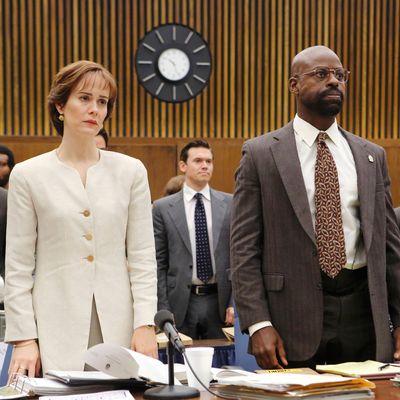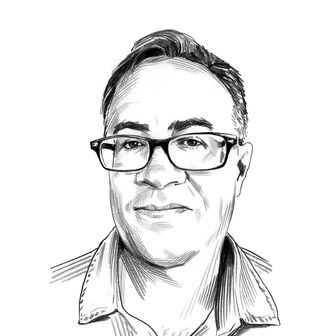
Those damn gloves.
They were perhaps the single most incriminating piece of evidence in the trial. One dark leather glove was found at the crime scene; the other was found near Kato Kaelin’s guest home on O.J. Simpson’s estate. Both gloves contained DNA evidence from Simpson, Nicole Brown, and Ron Goldman, and the glove at Simpson’s estate included a strand of long blonde hair similar to Nicole’s. The gloves connected the blood trail from Bundy Drive to Rockingham Avenue, and seemingly were enough to put Simpson away. Add the revelation on tonight’s The People v. O.J. Simpson about Nicole having purchased two extra-large pairs — out of only 300 issued — and there’s good reason why Robert Shapiro, even this deep into a trial that’s mostly been breaking the defense team’s way, wants to press for a plea deal.
And then, in one colossal prosecutorial screwup, the most damning evidence for Simpson’s conviction becomes Johnnie Cochran’s ace in the hole. Simpson tries on the gloves in front of the jury. They’re too small. Case closed. Never mind that the gloves had been saturated in blood, then frozen and unfrozen in the process of evaluating evidence. Never mind that Simpson was fitting them over another pair of sanitary gloves. Never mind that Simpson had both control of the evidence and the motive to make it look as impossible a struggle as a teenage boy fumbling with his first condom. The takeaway for the jury is that the glass slipper was too tight. They had not found their knife-wielding Cinderella.
If the show hadn’t already tipped its hand regarding Simpson’s guilt, then “Conspiracy Theories” lays those cards on the table. But it’s also clear about the distance between having the evidence and presenting the evidence — and in that sense, the jury can’t be entirely blamed for getting it wrong. The prosecution can have a solid motive, a timeline, and hard evidence proving their case, they can spend weeks telling their story through witnesses and exhibits. But what could be more persuasive than Simpson himself, standing right next to the jury box, squeezing his hands into gloves so tight that he likely couldn’t grip a blade handle? When it came time for the verdict, jurors could pore through their notes, parsing all the evidence and testimony — every word and scrap of it contested — and be utterly lost in the details. The gloves were a single, galvanizing moment of clarity. No one could sleep through that.
Following historical record, “Conspiracy Theories” lays the blame squarely on Christopher Darden for the tactical mistake, but it does allow him the dignity of an explanation. After a detective is forced to consider the unlikely theory that Brown and Goldman were the victims of cartel violence — a cynical theory floated by two words faxed from Alan Dershowitz: “Colombian necktie” — Marcia Clark laughs it off, but Darden takes the strategy more seriously. “It’s all stupid, but it lands,” he says. Once again, it’s a triumph of storytelling, a lurid and “exotic” tale to shake the jury out of its collective stupor. Darden longs for similar “big moments” for the prosecution, and the sight of this imposing Heisman-winning football legend standing in front of them, wearing the gloves in which he murdered two people, would be impossible to deny. If the gloves had fit, they must convict.
Nevertheless, Clark is adamantly opposed. She respects Darden enough to hear him out, but her bottom line is this excellent blackjack metaphor: “We’ve been dealt a king and a 10. I don’t know why you want to ask the dealer for another card.” Darden’s answer (“Because I know it’s an ace”) is that of a gambler’s certainty, the belief that the next turn of the card will bail him out of a losing streak when it will most likely deepen it. Darden didn’t necessarily kill the case by getting baited into defying Clark’s orders — exit interviews with jury members at the time made it sound like “not guilty” was an easy decision — but he made a grave error. And that brings us back to Darden’s ascendance to the prosecution team, and those uncomfortable questions of racial “optics” that haunted his appointment from the start. This wasn’t the first time Johnnie Cochran exposed Darden’s inexperience at trial.
“Conspiracy Theories” also ingeniously dovetails this hiccup in the prosecution’s case with the end of Clark and Darden’s flirtation. Their upstate getaway to Oakland, where Darden’s childhood best friend is celebrating a birthday, has romantic portents aplenty; the two getting smashed together at the bar further opens up the window of opportunity. It’s almost cruel, it seems, to lay their failed hookup at Darden’s feet — just one more example of the man’s inability to close the deal. The desire is there, thrumming in both of their eyes like cartoon hearts, but Darden lacks the conviction to make the move. When Clark ends the night with a pointedly formalized, “Good night, Darden,” it’s the latest in a series of doors that have closed — and will close — in his face.
Oh, if only Clark had taken the jury out for drinks. There’s no better soliloquy in the series than Clark responding to Darden’s friend’s assertion that the cops framed Simpson. Proving O.J.’s guilt may be difficult, but dismantling this particular conspiracy theory is easy work. For Mark Fuhrman and his “well-oiled conspiracy machine,” pulling off a successful frame job would involve an absurd sequence of events in which the men, somehow certain that O.J. had no alibi, sprinkled incriminating evidence all over Bundy, Rockingham, and the white Bronco, while eluding the intense scrutiny of their fellow officers and the press. Clark gives a masterful performance. It’s a prosecutorial magic trick with empty shot glasses as her props.
Has she convinced the jury? This skeptical observer offers a single ominous word: “Maybe.”
Dancing Itos:
- The timing of “Conspiracy Theories” had me thinking of two recent incidents in Donald Trump’s campaign — the alleged manhandling of now-former Breitbart News reporter Michelle Fields by campaign manager Corey Lewandowski, and the “Trump Nazi” that some people (including Trump’s son) misidentified as a Bernie Sanders plant — in which straightforward conclusions were rejected in favor of wildly unlikely, back-and-to-the-left conspiracy theories. It’s human nature to latch onto stories that confirm pre-held beliefs while rejecting those that don’t, Occam’s razor be damned. The Simpson defense team isn’t explicitly supporting the theory that the cops framed O.J., but in order to reject the prosecution’s “mountain of evidence,” the implication of LAPD conspiracy has to be considered. It may fall apart under scrutiny, but the “maybe” Clark gets after her barroom rebuttal proves that such theories are hard to upend.
- “Please don’t ever mention my hair again. Ever.” With that, The People v. O.J. Simpson has another GIF-able moment that will live on long past its run.
- “What’s out in the world osmoses back into that courtroom, sequester be damned,” Dershowitz tells his students. The case for transparency in our court system is usually a strong one, but this trial made a poor argument for it.
- David Schwimmer’s run as the series’ most tragic figure continues with a few terrific scenes in this episode. As Robert Kardashian, friend to both O.J. and Nicole, he cannot commit himself entirely to the defense and its paper-thin smokescreens on Colombian neckties. Knowing the strategy doesn’t convince him of its rightness — he knows it as a strategy to raise reasonable doubt, not an assertion of innocence. The trial is a torment for him that we couldn’t see on TV, but which the show has dramatized beautifully.
- Great scene with O.J. confronting Shapiro over his “I love cops” pin and his attempts to undermine Cochran, all meant to serve his reputation rather than his client’s interests. The show has been good about contrasting Shapiro’s misgivings about the case, which are rooted in self-interest and a lack of a conviction, with those of Kardashian, who’s vulnerable to Shapiro’s machinations because he’s genuinely torn up about what happened. No one has come out of the series looking worse than Shapiro.
- Sad close with Darden leaving a message for Fred Goldman, though I suppose it would have been sadder had Mr. Goldman answered.


